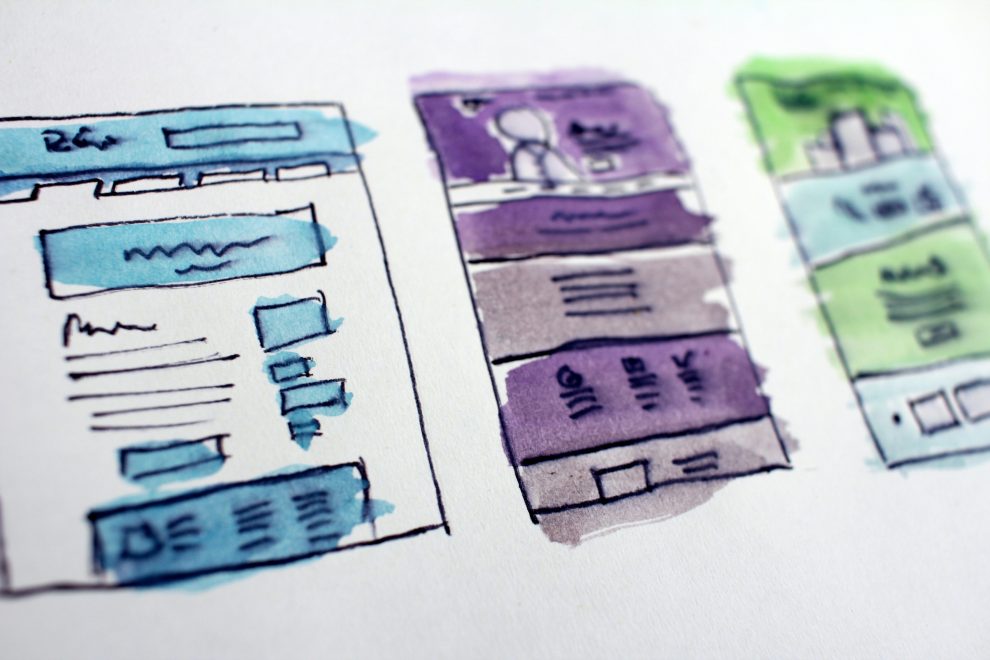UX/UI design plays a pivotal role in enhancing mobile app development in the USA. These design aspects are the cornerstone of user satisfaction and engagement. User-centric interfaces and intuitive experiences are fundamental in attracting and retaining users.
Firstly, UX design ensures that apps are tailored to meet users’ needs and preferences, making them more likely to use the app regularly. It involves conducting user research, creating user personas, and mapping out user journeys to develop a deep understanding of the target audience.
Secondly, UI design focuses on the visual appeal and usability of the app. A well-designed user interface with intuitive navigation and aesthetically pleasing elements enhances user satisfaction and encourages users to explore the app’s features.
Moreover, in a competitive mobile app market like the USA, outstanding UX/UI design sets an app apart. Positive user experiences lead to higher user ratings and reviews, which, in turn, improve app visibility and downloads.
In conclusion, UX/UI design plays a vital role in elevating mobile app development in the USA by creating user-friendly, visually appealing, and competitive applications that resonate with users and drive success in the ever-evolving mobile landscape.
User Experience (UX) is of paramount importance in the realm of mobile app development

User Experience (UX) stands as the linchpin in the domain of mobile app development, holding unparalleled significance. It’s the crux upon which the success or failure of an app often hinges. In the highly competitive landscape of mobile applications, creating an exceptional UX is no longer an option but a necessity.
A well-crafted UX can make or break an app’s reputation. It encompasses the entire journey of a user within the app, from the initial interaction to ongoing engagement. It involves factors like intuitive navigation, aesthetic design, seamless functionality, and responsiveness, all tailored to ensure users have a frictionless and enjoyable experience.
Moreover, positive UX directly influences user retention and acquisition. Satisfied users are more likely to stick around, use the app regularly, and recommend it to others. Conversely, a poor UX can lead to quick uninstallation and negative reviews, eroding an app’s reputation and user base.
In summary, UX is the heartbeat of mobile app development. Prioritizing user experience ensures an app’s competitiveness, fosters user loyalty, and drives its success in the dynamic and demanding world of mobile applications. Ignoring UX is akin to setting an app up for failure in an environment where user expectations continue to rise.
The Role of UI/UX Design in Mobile App Development

UI/UX design plays a pivotal role in mobile app development, driving its success in the highly competitive market. These design elements are not mere embellishments; they are the bedrock of user satisfaction and engagement.
UX design focuses on understanding user needs, preferences, and behaviors. It involves thorough research, user personas, and journey mapping to ensure the app addresses user pain points and provides a seamless experience. By actively involving users in the design process, developers can create intuitive interfaces that enhance user satisfaction.
UI design, on the other hand, deals with the visual and interactive aspects of the app. It encompasses layout, color schemes, typography, and overall aesthetics. An attractive and user-friendly interface can significantly impact a user’s perception of the app, making it more appealing and easy to navigate.
In the mobile app market, first impressions matter. A well-crafted UI/UX can distinguish an app from competitors, attract users, and encourage them to stay. Positive user experiences lead to higher user retention, positive reviews, and word-of-mouth recommendations, all contributing to an app’s long-term success.
In conclusion, UI/UX design actively shapes the trajectory of mobile app development, ensuring that apps meet user expectations, stand out in the market, and ultimately thrive in an increasingly user-centric digital landscape.
User Interface (UI) Design Elements for Mobile Apps

User Interface (UI) design is a critical aspect of mobile app development that directly impacts the user experience. Several key elements are essential for creating an effective UI in mobile apps.
- Layout: The arrangement of elements on the screen should be intuitive and visually pleasing. An organized layout guides users through the app’s content and functionalities.
- Navigation: Easy and straightforward navigation is paramount. Clear menus, buttons, and gestures help users move seamlessly within the app and find what they need.
- Typography: Choosing the right fonts for text elements is crucial. Legible fonts enhance readability, while font size and spacing should be optimized for mobile screens.
- Color Scheme: A thoughtfully chosen color palette creates a visually appealing and cohesive look. Colors can convey emotions, brand identity, and hierarchy within the app.
- Icons and Images: Use appropriate icons and images to convey information and guide user actions. These visual elements should align with the app’s overall design.
- Consistency: Maintain consistency in design elements throughout the app to provide a cohesive user experience. Consistency in buttons, fonts, and navigation patterns enhances user familiarity.
- Responsiveness: Ensure that the UI elements respond promptly to user interactions. Smooth transitions and feedback animations create a more engaging experience.
- Accessibility: Consider accessibility features, such as scalable text, alternative text for images, and support for screen readers, to make the app inclusive for all users.
- Feedback and Confirmation: Provide clear feedback to users when they perform actions, such as submitting forms or completing tasks, to confirm their actions were successful.
- User Testing: Continuously test the UI with real users to gather feedback and make improvements based on their insights.
Incorporating these UI design elements into mobile apps enhances usability, user satisfaction, and the overall success of the application. A well-designed UI can set an app apart and foster a positive user experience.
User Experience (UX) Design Elements for Mobile Apps

User Experience (UX) design is paramount in creating mobile apps that resonate with users and deliver a seamless and satisfying interaction. Several essential elements contribute to effective UX design for mobile apps:
User Research :
Understanding the target audience is fundamental. UX designers conduct research to identify user needs, preferences, pain points, and behaviors, which informs the app’s design.
User Personas :
Creating user personas helps designers visualize and empathize with different user types, enabling them to tailor the app’s features and functionality to specific user groups.
User Journey Mapping :
Mapping out the user’s path through the app helps identify potential friction points and opportunities for improvement in the user experience.
Information Architecture :
Organize the app’s content and features logically to make it easy for users to find what they’re looking for. A clear and intuitive structure is crucial.
Wireframing and Prototyping :
These tools help designers sketch out the app’s layout and interactions, allowing for early testing and refinement of design concepts.
Usability Testing :
Conducting usability tests with real users helps identify usability issues and gather feedback for iterative improvements.
Responsive Design :
Ensure that the app works seamlessly across various devices and screen sizes, adapting its layout and functionality as needed.
Intuitive Navigation :
Design a user-friendly navigation system that guides users through the app effortlessly, with clear menus, buttons, and gestures.
Effective UX design considers these elements to create mobile apps that not only meet user needs but also delight and retain users over time. A positive user experience can lead to increased user engagement, loyalty, and positive word-of-mouth recommendations.
The Importance of User Testing for UI/UX Design in Mobile App Development

User testing holds immense significance in the realm of UI/UX design within mobile app development. It serves as a crucial step in the iterative design process, ensuring that the app’s interface and user experience meet and exceed user expectations.
Firstly, user testing provides invaluable insights into user behavior and preferences. It allows designers and developers to observe how real users interact with the app, revealing usability issues, pain points, and areas for improvement that might not be apparent through internal assessments.
Secondly, it validates design decisions and helps refine the user interface. Testing early prototypes or wireframes helps identify design flaws and allows for necessary adjustments, ultimately leading to a more user-friendly and intuitive interface.
Furthermore, user testing promotes user-centric design. By actively involving users in the design process, it ensures that the app caters to their needs, enhancing user satisfaction and reducing the risk of costly post-launch modifications.
Lastly, it mitigates the risk of poor user adoption and negative reviews. Addressing usability issues and improving the user experience based on feedback garnered from testing sessions can result in a well-received and successful app, minimizing the likelihood of user frustration and uninstallations.
In conclusion, user testing is a pivotal step in mobile app development, guaranteeing that UI/UX design aligns with user expectations, thereby contributing to the creation of apps that are user-friendly, engaging, and ultimately successful in the competitive app market.
FAQ’S
1. What is UX/UI design, and why is it essential for mobile app development in the USA?
- UX (User Experience) design focuses on creating a positive and seamless user journey within an app, while UI (User Interface) design deals with the visual and interactive aspects. They are essential as they significantly impact user satisfaction, engagement, and an app’s success in a competitive market like the USA.
2. How does UX/UI design contribute to user satisfaction?
- UX/UI design ensures that an app is user-friendly, intuitive, and aesthetically pleasing, leading to improved user satisfaction. It addresses user needs, provides clear navigation, and enhances the overall user experience.
3. What are some key elements of UX/UI design in mobile app development?
- Key elements include user research, persona development, user journey mapping, intuitive navigation, responsive design, aesthetics, and accessibility features, among others. These elements collectively contribute to a successful app.
4. How can good UX/UI design impact an app’s competitiveness in the USA mobile app market?
- Well-designed apps with excellent UX/UI are more likely to stand out, attract users, and receive positive reviews. This positive feedback can lead to increased downloads and user retention, giving the app a competitive edge.
5. Are there any examples of successful mobile apps in the USA that have excelled due to their UX/UI design?
- Yes, many successful apps in the USA, such as Instagram, Airbnb, and Uber, owe their success in part to their exceptional UX/UI design, which has contributed to their widespread adoption and user loyalty.

















